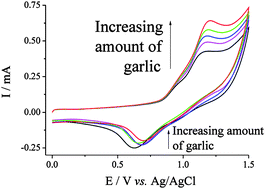A simple but sensitive technique has been demonstrated towards the electroanalytical quantification of the strength of garlic. This technique can also be used to quantify dialkyldisulfides. The cyclic voltammetry of bromide was found to be a sensitive electrochemical probe, electrogenerated bromine reacting with dialkyldisulfides to catalytically regenerate bromide, resulting in a significant increase in peak current. A linear response of current vs. concentration was observed between 0.1 and 15 mM dipropyldisulfide at edge plane pyrolytic graphite (EPPG) electrodes; a smaller range up to ca. 5 mM was available at screen printed carbon electrodes (SPCEs), with a detection limit (from 3σ) of 0.067 mM. The response of diallyldisulfide was found to be essentially identical. Shaking garlic puree in acetonitrile for 5 minutes, followed by dilution with water then recording the voltammetry at the cheap, disposable SPCE gave a linear trend in current with respect to the quantity of garlic present, corresponding to the diallyldisulfide extracted. This has potential applications in monitoring the garlic content of medicinal supplements, batch-to-batch variation and the stability of garlic during storage.

You have access to this article
 Please wait while we load your content...
Something went wrong. Try again?
Please wait while we load your content...
Something went wrong. Try again?


 Please wait while we load your content...
Please wait while we load your content...